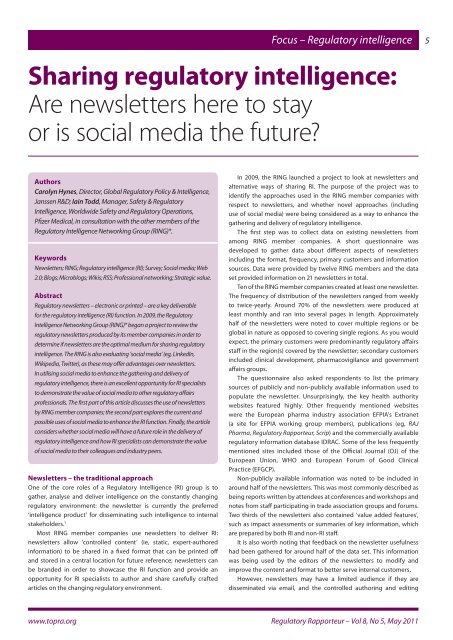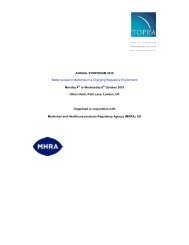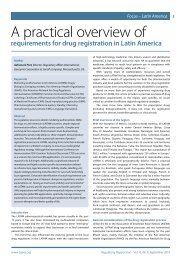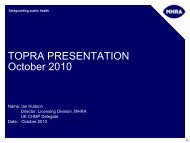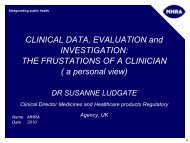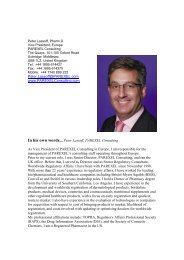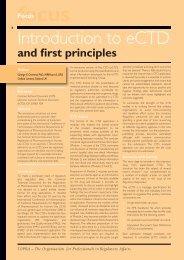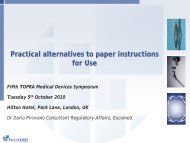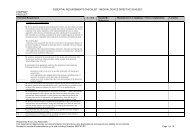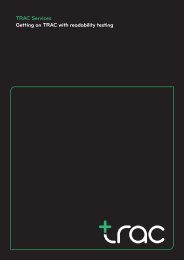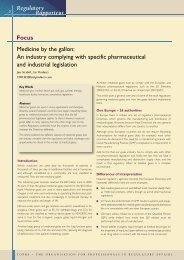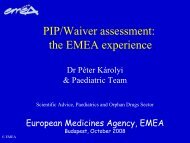Sharing regulatory intelligence: Are newsletters here to ... - TOPRA
Sharing regulatory intelligence: Are newsletters here to ... - TOPRA
Sharing regulatory intelligence: Are newsletters here to ... - TOPRA
- No tags were found...
You also want an ePaper? Increase the reach of your titles
YUMPU automatically turns print PDFs into web optimized ePapers that Google loves.
6Focus – Regula<strong>to</strong>ry <strong>intelligence</strong>Networking sites allow individuals <strong>to</strong> tap in<strong>to</strong>the combined wisdom of other <strong>regula<strong>to</strong>ry</strong>professionals – questions and answers can beexchanged in real time rather than waiting forthe outcome of a formal consultation processprocess doesn’t allow large numbers of people <strong>to</strong> share their opinionor experiences. The construction of the newsletter can also becumbersome, with more time spent on formatting the articles in thenewsletter template than writing the articles themselves.With some of the limitations of <strong>newsletters</strong> in mind, a secondsurvey was circulated <strong>to</strong> the RING member companies in mid-2010. The purpose of this survey was <strong>to</strong> establish what novel <strong>to</strong>ols/approaches were being considered that could enhance the deliveryof RI, including au<strong>to</strong>mating the process for creating electronic<strong>newsletters</strong>. Unsurprisingly, many of the <strong>to</strong>ols under consideration fellunder the category of social media.Social media – a new approachOrganisations and institutions of all sizes are embracing socialmedia - their power, impact and value becoming more apparent inthe last few years. Social media have enabled real-time reporting ofpolitical demonstrations and provided platforms for viral marketingcampaigns that reach global audiences in a matter of seconds.Put simply, social media enable social interaction and informationexchange on the internet. They are, according <strong>to</strong> Kaplan and Haenlein,“internet applications that build on the ideological and technologicalfoundations of Web 2.0”. 2W<strong>here</strong>as Web 1.0 was about accessing static, prescribed content,Web 2.0 is about creating dynamic, user-generated content, theimportance of which is determined by the “crowd”.According <strong>to</strong> Kaplan and Haenlein, t<strong>here</strong> are six different types ofsocial media:l Collaborative projects, eg, Wikipedia (collaborative authoring)l Blogs and microblogs, eg, Twitterl Content communities, eg, Delicious (social bookmarking)l Social networking sites, eg, FaceBookl Virtual game worldsl Virtual communities, 3 eg, YouTube (video-sharing community).How are social media utilised by RI specialists <strong>to</strong>day?Blogs: These are fast becoming the medium of choice for amateurs andexperts alike <strong>to</strong> share their opinions on a particular subject matter. Short for‘weblog’, blogs are, in essence, on-line diaries; collectively, they are knownas the ‘blogosp<strong>here</strong>’. The blog is an excellent vehicle for RI specialistsand other professionals in <strong>regula<strong>to</strong>ry</strong> affairs <strong>to</strong> share their insights andexperiences on the changing <strong>regula<strong>to</strong>ry</strong> environment. T<strong>here</strong> are a numberof <strong>regula<strong>to</strong>ry</strong>-orientated blogs on the web: Eye on FDA and the FDA law blogare a couple of good examples – both authored by experts. 4Frequently, blogs are accompanied by discussion boards andcommenting facilities. These allow readers <strong>to</strong> add their experiencesand <strong>to</strong> challenge the thoughts from others in order <strong>to</strong> create arich stream of <strong>intelligence</strong> that can be easily shared with others. Inthat regard, the blog offers an easy way <strong>to</strong> extract tacit <strong>regula<strong>to</strong>ry</strong>knowledge (unpublished know-how) from the minds of colleaguesw<strong>here</strong> it might otherwise stay, reducing the need for lengthy face<strong>to</strong>-faceinterviews. Blogs might also provide a useful vehicle forgathering comments on draft <strong>regula<strong>to</strong>ry</strong> authority guidelines orfeedback on health authority initiatives.Microblogs: These allow users <strong>to</strong> post short statements (usually 140characters) for others <strong>to</strong> view and comment on. Twitter is probablythe most well-known microblog site – a site that allows users <strong>to</strong>follow a multitude of microbloggers, although t<strong>here</strong> are others, suchas Tumblr and Plurk, with similar functionality.Twitter has a number of pharma/<strong>regula<strong>to</strong>ry</strong> affairs-orientatedmicroblogs that individuals can follow (eg, Tim Felgate, EFPIA,PharmaFocus and Pharma IQ). These microblogs provide acontinuous stream of pharma and <strong>regula<strong>to</strong>ry</strong> news and providean alternative way <strong>to</strong> be alerted <strong>to</strong> the presence of newly released<strong>regula<strong>to</strong>ry</strong> authority documents.One potential application of microblogs for the RI specialist is <strong>to</strong>use them as a <strong>to</strong>ol <strong>to</strong> provide real-time reporting of presentationsbeing delivered at conferences – presentations that might containuseful <strong>intelligence</strong> (eg, release dates of important new guidelines oreagerly anticipated regula<strong>to</strong>r initiatives). Due <strong>to</strong> their one-<strong>to</strong>-manydissemination feature, microblogs allow any number of internalstakeholders <strong>to</strong> follow the posts of their RI colleagues and commentas necessary. In that regard, microblogs make a useful alternative <strong>to</strong>lengthy email chains that can only be viewed by a limited number ofpeople at any one time.Wikis: Most people have heard of Wikipedia – the web-basedencyclopaedia <strong>to</strong> which anyone can contribute. The ‘wiki’ (theHawaiian word for quick) offers a collaborative space for multipleauthors <strong>to</strong> create online documents that can be viewed and editedby any number of stakeholders. T<strong>here</strong> are several applications ofwikis for RI specialists, for example <strong>to</strong> create briefing documentson specific <strong>regula<strong>to</strong>ry</strong> <strong>to</strong>pics or for an encyclopaedia of <strong>regula<strong>to</strong>ry</strong>terms. These documents can be accessible <strong>to</strong> everyone within anorganisation (ie, displayed on an RI intranet site) and can be usefulquick references for senior management, new starters or non<strong>regula<strong>to</strong>ry</strong>affairs professionals <strong>to</strong> facilitate their understanding ofkey <strong>regula<strong>to</strong>ry</strong> issues.Social/professional networking: Social networking platforms suchas FaceBook, MySpace and Bebo are seen as the sole preserve oftech-savvy teenagers. For professionals who do not see these <strong>to</strong>ols asserious applications but want <strong>to</strong> connect with one another, t<strong>here</strong> arethe more ‘grown-up’ professional networking sites such as LinkedInand Ryze. LinkedIn also has a number of special interest groups specific<strong>to</strong> <strong>regula<strong>to</strong>ry</strong> affairs that individuals can join (by application) – forexample, <strong>TOPRA</strong> and ‘Reg-Info’. These interest groups are being used <strong>to</strong>exchange <strong>intelligence</strong> and advice on <strong>regula<strong>to</strong>ry</strong> matters. In that respect,LinkedIn offers a faster alternative <strong>to</strong> trade associations when it comes<strong>to</strong> garnering industry experience on a particular <strong>regula<strong>to</strong>ry</strong> issue ortapping in<strong>to</strong> the combined wisdom of other <strong>regula<strong>to</strong>ry</strong> professionals.Questions and answers can be exchanged in real time rather thanwaiting for the outcome of a formal consultation process.If data are mined appropriately (ie, within the terms of the useragreements and privacy policies), these professional networking sitescould also facilitate key opinion leader (KOL) mapping exercises andprofessional profiling requests.Regula<strong>to</strong>ry Rapporteur – Vol 8, No 5, May 2011www.<strong>to</strong>pra.org
Focus – Regula<strong>to</strong>ry <strong>intelligence</strong>7For RI specialists whose company establishes their own internalnetworking platform, one application could be <strong>to</strong> use it <strong>to</strong> identifyinternal subject matter experts when seeking comments coordina<strong>to</strong>rsfor draft <strong>regula<strong>to</strong>ry</strong> authority document reviews.RSS, news aggrega<strong>to</strong>rs and tagging: RSS (Really SimpleSyndication) and news aggrega<strong>to</strong>rs enable RI specialists <strong>to</strong> au<strong>to</strong>matethe gathering of online content from a multitude of <strong>regula<strong>to</strong>ry</strong>websites (assuming they are RSS-enabled) and view them in oneplace.The US FDA and EMA websites are now RSS-enabled, as are somenational competent authority sites. The <strong>intelligence</strong>-gathering netcan be cast much wider and use of aggregation <strong>to</strong>ols can releasethe time used by RI specialists in manually checking each and everywebsite for updates – time that can be better spent on providinganalysis and perspective. The downside is that no ‘human filter’ isapplied <strong>to</strong> the information gat<strong>here</strong>d, and thus the news feed couldbe full of ‘irrelevant noise’.Tagging and ‘tag clouds’ are replacing traditional folderstructures in electronic document reposi<strong>to</strong>ries, expediting s<strong>to</strong>rageand retrieval and t<strong>here</strong>by facilitating access <strong>to</strong> key <strong>regula<strong>to</strong>ry</strong><strong>intelligence</strong> material. For example, meeting minutes from aconference can be uploaded and tagged (tags are single wordsthat capture the subject matter of the document, like the keywordsabove) and then retrieved quickly by clicking on those same tags inthe tag cloud (rather than having <strong>to</strong> search through multiple layersof folders). As tags get re-used, so they alter in size (and sometimescolour) allowing the reader <strong>to</strong> quickly see which <strong>to</strong>pics are the mostpopular or frequently cited.Is social media the future of <strong>regula<strong>to</strong>ry</strong> <strong>intelligence</strong>?The RING’s opinion is that social media will have a role; however, theextent of that role is not yet clear. At least two of the following thingsmust happen: firstly, the strengths and opportunities of social media(in a <strong>regula<strong>to</strong>ry</strong> setting) must outweigh the weaknesses and thethreats, particularly as benchmarked against traditional approachessuch as the newsletter; secondly, the RI function must be prepared<strong>to</strong> proactively demonstrate the value of social media <strong>to</strong> internalcus<strong>to</strong>mers and industry peers via a well-planned and carefullyimplemented engagement strategy, and <strong>to</strong> persevere with thisstrategy if t<strong>here</strong> is resistance the first time around. The success of eachof those elements will determine the extent <strong>to</strong> which social mediawill play a role in the future delivery of <strong>regula<strong>to</strong>ry</strong> <strong>intelligence</strong>, ie,more success equals a greater role. The second RING member surveyrevealed relatively low uptake of social media in both the RI functionsand the RING member organisations in general, so t<strong>here</strong> is still muchwork <strong>to</strong> be done.Strengths and opportunitiesSocial media have the potential <strong>to</strong> expedite or improve thegathering, dissemination and s<strong>to</strong>ring of <strong>regula<strong>to</strong>ry</strong> <strong>intelligence</strong>. RSSand news aggrega<strong>to</strong>rs au<strong>to</strong>mate the gathering process and allowmore sources <strong>to</strong> be tracked at the same time. Social media removebarriers <strong>to</strong> participation, effectively allowing online conferences<strong>to</strong> take place with a much wider degree of audience participation.They also enable the sharing of tacit knowledge, something thatknowledge management strategies frequently fail <strong>to</strong> accomplish. Inshort, social media improve operational efficiency and provide newsources of <strong>intelligence</strong>.Weaknesses and threatsThe second RING member survey revealed that technology platformsincorporating social media are not being taken up, predominantly due<strong>to</strong> budget constraints and the limitations of the technology. However,t<strong>here</strong> is also a cultural element that drives resistance <strong>to</strong> social media,despite the advantages mentioned above.Regula<strong>to</strong>ry affairs professionals are busy people. Commenting on anRI colleague’s blog post or following a real-time report via a microblogtakes up precious time. The attitude is that these activities divertattention away from ‘business-critical’ activities. The appropriatenessof social media in the <strong>regula<strong>to</strong>ry</strong> setting is also questioned. T<strong>here</strong> isthe fear that an off-the-cuff remark typical of a social media exchangewill be circulated quickly and read by many, with retaliation followingswiftly if reputations are damaged. Unfortunately, some of the mostuseful <strong>regula<strong>to</strong>ry</strong> <strong>intelligence</strong> – perhaps that concerning specificindividuals – cannot be written down, as it may have legal ramifications.These concerns and threats are legitimate but they can be avoided withcareful use. A ‘Best Practice Guide’ or policy, with specific examples,can help colleagues use social media responsibly in the workplace andavoid some of the threats mentioned above. These policies are usuallyapplied at the organisation level and are not specific <strong>to</strong> <strong>regula<strong>to</strong>ry</strong>.How can the RI function demonstrate the value of socialmedia <strong>to</strong> its organisation?In a recent report, the management consultants McKinsey & Conoted: “The most intensive users of Web 2.0 [and by implicationsocial media] are enjoying the biggest growth in market share. Manyexecutives also see a positive impact on information sharing withintheir organisations.” 5 Clearly, industry is recognising the value of socialmedia and RI specialists should build on that momentum.T<strong>here</strong> are a number of strategies and tactics that could be used <strong>to</strong>demonstrate the value of social media <strong>to</strong> colleagues and industry peers.As with most strategies, a successful outcome will turn on a few criticalsuccess fac<strong>to</strong>rs (CSFs) and efforts should be focused on achieving these.In short, a successful outcome will see any cultural resistance <strong>to</strong> socialmedia fall with a concomitant rise in user uptake and participation. Theformer is difficult <strong>to</strong> measure (base-lining can be done through peer<strong>to</strong>-peersurveys); however, the latter can be measured and makes for auseful success metric. Some strategies and tactics include:l Develop and implement an effective communications strategy<strong>to</strong> promote the use and added value of social media within a<strong>regula<strong>to</strong>ry</strong> context. Seminars or ‘road show’ type events might bethe best vehicle <strong>to</strong> do this.l Highlight examples w<strong>here</strong> social media yielded vital <strong>intelligence</strong>(not likely <strong>to</strong> be captured by other means) that influenced strategicdecision-making (CSF).l Allay colleagues’ fears over appropriateness or retaliation bydemonstrating how potential threats can be avoided. Developgood practice guidelines <strong>to</strong> facilitate this threat management.l Dispel colleagues’ notions of ‘time-wasting’ by demonstratinghow participation is quick and easy and can encourage others <strong>to</strong>contribute with positive results.l Get senior management buy-in. If the CEO or the head of<strong>regula<strong>to</strong>ry</strong> affairs blogs or ‘tweets’ or is shown <strong>to</strong> be supportiveand actively engaged in your social media strategy, so others lowerdown the organisation will likely participate. An organisationwide(and funded) social media initiative is also more likely <strong>to</strong> beimplemented, on which the RI specialist can ‘piggy-back’.www.<strong>to</strong>pra.org Regula<strong>to</strong>ry Rapporteur – Vol 8, No 5, May 2011
8Focus – Regula<strong>to</strong>ry <strong>intelligence</strong>In continuing the momentum of any successfulsocial media strategy, the RI function mustdemonstrate that it is deriving new insightsthat can be leveraged for strategic advantagel Emphasise the return-on-investment (ROI) of social media. Manyapplications are free but the additional <strong>intelligence</strong> and operatingefficiencies could provide a competitive advantage and reduceopportunity costs at the same time (CSF).l Ensure any initiative is aligned with your organisation’s policy onusing social media.l Pilot a number of social media initiatives within the <strong>regula<strong>to</strong>ry</strong>department based on the suggested uses above. Incorporatesocial media in<strong>to</strong> formal business processes; for example, usingblogs or discussion boards <strong>to</strong> gather comments on draft <strong>regula<strong>to</strong>ry</strong>authority guidelines.l Create a number of super-users that can champion the virtues ofsocial media.l Partner with your organisation’s business or IT groups <strong>to</strong> leveragetheir expertise and align with any similar social media initiativesthey might be implementing.l Create awareness on which <strong>to</strong>ols are available already and mightbe used without major additional investments in technology.l Partner with your organisation’s training group <strong>to</strong> develop ondemandweb-based training that will educate colleagues on how<strong>to</strong> use the social media <strong>to</strong>ols, <strong>to</strong> help overcome any ‘technophobia’they might have.In continuing the momentum of any successful social mediastrategy, the RI function must demonstrate that it is managing thenoise that some social media bring and is deriving new insights thatcan be leveraged for strategic advantage. One or two bad experiences(eg, delivering wrong <strong>intelligence</strong> or accidentally sharing proprietaryinformation with a competi<strong>to</strong>r) will undo everything.ConclusionsNewsletters are a key deliverable for the RI function and t<strong>here</strong>is perhaps an expectation among RI and other <strong>regula<strong>to</strong>ry</strong> affairsprofessionals that they should stay. However, social media haverisen in prominence and clearly have a purpose in a professionalsetting. RI specialists are starting <strong>to</strong> use social media more andmore in their daily work. Social media cannot replace the minds ofexperienced <strong>regula<strong>to</strong>ry</strong> professionals when it comes <strong>to</strong> providinginsight and perspective on the changing <strong>regula<strong>to</strong>ry</strong> environment;however, they have the potential <strong>to</strong> enhance the current methodsused <strong>to</strong> gather, manage and deliver <strong>regula<strong>to</strong>ry</strong> <strong>intelligence</strong> <strong>to</strong>internal stakeholders.Social media will have a role <strong>to</strong> play in the future of <strong>regula<strong>to</strong>ry</strong><strong>intelligence</strong>. The extent of that role will depend on how successfulthe RI function is in demonstrating the strengths and opportunitiesof social media versus their weaknesses and threats (as comparedwith more traditional methods). It will also depend on resources andexpertise within the RI function –RI specialists must become moreknowledgeable themselves and keep up with the latest advances.This means frequent outreach and partnering with IT professionals inthe same organisation.The expectations, preferences and needs of internal stakeholderswill also determine the future of social media. If internal surveysfavour <strong>newsletters</strong> even after repeated attempts <strong>to</strong> demonstratethe value of social media, then any further efforts <strong>to</strong> promote socialmedia may be actively resisted. Of course, one compromise is that<strong>newsletters</strong> and social media unite <strong>to</strong> form an <strong>intelligence</strong> ‘mashup’in one space. Some content will be controlled; other content willstream in via embedded social media <strong>to</strong>ols. Indeed, some technologyvendors already offer so-called integrated solutions that allow this <strong>to</strong>happen. A mixture of the old and the new may be the answer and willsee both the newsletter and social media play a role in the future of<strong>regula<strong>to</strong>ry</strong> <strong>intelligence</strong>.About EU RING*The Regula<strong>to</strong>ry Intelligence Networking Group (RING) is an industryforum whose creation in 2006 was prompted by the emergence of a newprofession of <strong>regula<strong>to</strong>ry</strong> <strong>intelligence</strong> specialists in the pharmaceuticaland biopharmaceutical sec<strong>to</strong>rs. RING comprises representatives fromsome of the largest companies in the industry and aims <strong>to</strong> centralisenon-confidential <strong>regula<strong>to</strong>ry</strong> information. Its objective is <strong>to</strong> increasethe efficiency and recognition of <strong>regula<strong>to</strong>ry</strong> <strong>intelligence</strong> by sharingprocesses, practices and experience in non-product specific and nonconfidentialareas.The RING comprises the following individuals: Ulrika Assargaard,Head Regula<strong>to</strong>ry Intelligence at Hoffmann La Roche; ElisabethFournier-Qezari, Direc<strong>to</strong>r Regula<strong>to</strong>ry Intelligence, EU & other regionsat Sanofi-Aventis; Carolyn Hynes, Direc<strong>to</strong>r Global Regula<strong>to</strong>ry Policy& Intelligence at Janssen R&D; Angelika Joos, Head Regula<strong>to</strong>ry PolicyEurope & RoW at MSD; Marianne Köhne, Head Regula<strong>to</strong>ry IntelligenceOffice at Boehringer Ingelheim; Christine Mayer-Nicolai, Direc<strong>to</strong>r,Head Global Regula<strong>to</strong>ry Intelligence & European Regula<strong>to</strong>ry Policy atMerck Serono; Helene Orme, Senior Manager Regula<strong>to</strong>ry Policy andIntelligence at Abbott; Elaine Whiting, Associate Direc<strong>to</strong>r Regula<strong>to</strong>ryPolicy, Intelligence and Labelling at AstraZeneca; Merete Schmiegelow,Regula<strong>to</strong>ry Direc<strong>to</strong>r, Regula<strong>to</strong>ry Policies and Intelligence at NovoNordisk; Helene Thybo, Regula<strong>to</strong>ry Professional Regula<strong>to</strong>ry Intelligenceat Leo Pharma; Iain Todd, Manager Safety and Regula<strong>to</strong>ry Intelligenceat Pfizer; Carol Walker, Manager, Regula<strong>to</strong>ry Intelligence and SOPsat Gilead; Birgit Wolf, Regula<strong>to</strong>ry Intelligence Manager EU at BayerPharma AG; Alexa Hunter, Head Regula<strong>to</strong>ry Intelligence at MerzPharmaceuticals.References1 Regula<strong>to</strong>ry Intelligence Networking Group (RING). ‘The CompanyRegula<strong>to</strong>ry Intelligence (RI) Function’, RAJ Pharma, Informa Healthcare, Oct2007, p671-673.2 Kaplan Andreas M, Michael Haenlein (2010). ‘Users of the world, unite! Thechallenges and opportunities of social media’, Business Horizons, 2010; 53(1): pp59–68.3 Ibid.4 Senak M. ‘Eye on FDA’, http://www.eyeonfda.com/ (accessed 15 February2011); Wasserstein J, Kars K, FDA law blog, http://www.fdalawblog.net/,Hyman Phelps, McNamara PC, (accessed 15 February 2011).5 ‘McKinsey global survey results: How Web 2.0 is helping companiescompete’, McKinsey & Company (2010).Regula<strong>to</strong>ry Rapporteur – Vol 8, No 5, May 2011www.<strong>to</strong>pra.org


